Comprehensive Report: Cloud Architecture Functions and Advantages
VerifiedAdded on 2019/09/25
|10
|2741
|483
Report
AI Summary
This report provides a detailed analysis of cloud architecture, a critical concept in modern business. It begins with an introduction to cloud architecture, emphasizing its significance and evolution in response to technological advancements. The report then outlines the core functions of cloud architecture, including data storage, security, and problem-solving capabilities, highlighting its role in ensuring data confidentiality and facilitating market trend analysis. It further delves into the benefits of cloud computing architecture, such as cost savings, enhanced security, increased flexibility, and improved mobility, while also acknowledging potential disadvantages like vulnerability to attacks and dependency on network connectivity. The report also classifies cloud computing into public, private, and hybrid models and explains the different cloud service models, namely SaaS, IaaS, and PaaS. Finally, the report offers strategies for effective cloud architecture implementation, emphasizing security enhancements and the importance of encryption.
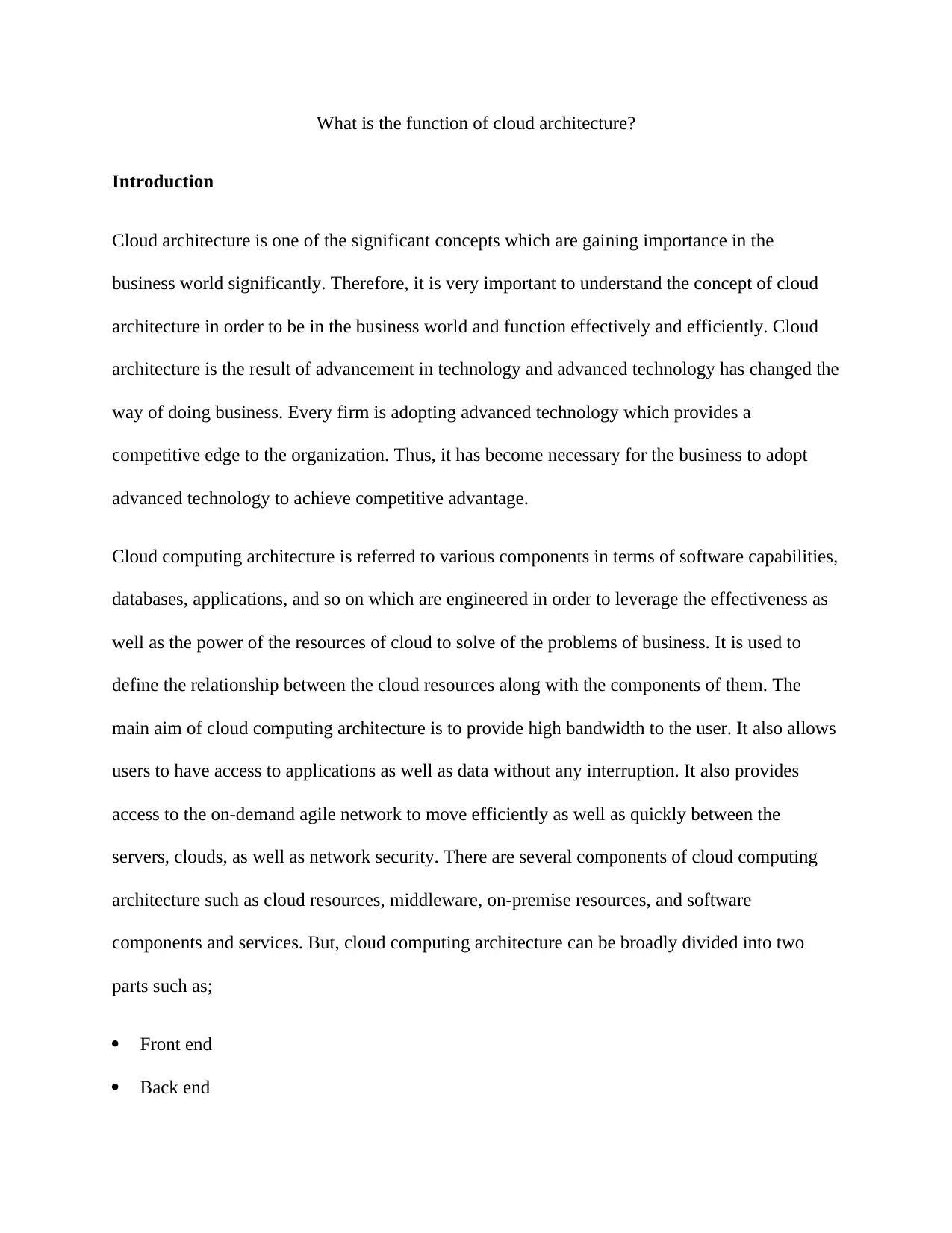
What is the function of cloud architecture?
Introduction
Cloud architecture is one of the significant concepts which are gaining importance in the
business world significantly. Therefore, it is very important to understand the concept of cloud
architecture in order to be in the business world and function effectively and efficiently. Cloud
architecture is the result of advancement in technology and advanced technology has changed the
way of doing business. Every firm is adopting advanced technology which provides a
competitive edge to the organization. Thus, it has become necessary for the business to adopt
advanced technology to achieve competitive advantage.
Cloud computing architecture is referred to various components in terms of software capabilities,
databases, applications, and so on which are engineered in order to leverage the effectiveness as
well as the power of the resources of cloud to solve of the problems of business. It is used to
define the relationship between the cloud resources along with the components of them. The
main aim of cloud computing architecture is to provide high bandwidth to the user. It also allows
users to have access to applications as well as data without any interruption. It also provides
access to the on-demand agile network to move efficiently as well as quickly between the
servers, clouds, as well as network security. There are several components of cloud computing
architecture such as cloud resources, middleware, on-premise resources, and software
components and services. But, cloud computing architecture can be broadly divided into two
parts such as;
Front end
Back end
Introduction
Cloud architecture is one of the significant concepts which are gaining importance in the
business world significantly. Therefore, it is very important to understand the concept of cloud
architecture in order to be in the business world and function effectively and efficiently. Cloud
architecture is the result of advancement in technology and advanced technology has changed the
way of doing business. Every firm is adopting advanced technology which provides a
competitive edge to the organization. Thus, it has become necessary for the business to adopt
advanced technology to achieve competitive advantage.
Cloud computing architecture is referred to various components in terms of software capabilities,
databases, applications, and so on which are engineered in order to leverage the effectiveness as
well as the power of the resources of cloud to solve of the problems of business. It is used to
define the relationship between the cloud resources along with the components of them. The
main aim of cloud computing architecture is to provide high bandwidth to the user. It also allows
users to have access to applications as well as data without any interruption. It also provides
access to the on-demand agile network to move efficiently as well as quickly between the
servers, clouds, as well as network security. There are several components of cloud computing
architecture such as cloud resources, middleware, on-premise resources, and software
components and services. But, cloud computing architecture can be broadly divided into two
parts such as;
Front end
Back end
Paraphrase This Document
Need a fresh take? Get an instant paraphrase of this document with our AI Paraphraser

Both parts are connected through a network which is usually called the internet. The front end of
the cloud computing architecture is considered as client part of the system. The front end consists
of applications as well as interfaces which are needed to access the cloud computing platforms
such as a web browser. On the other hand, the back end is referred to as the cloud itself. It
includes all the resources which are required to provide cloud computing services.
Benefits of cloud computing architecture
Cloud computing architecture is widely being used in the businesses as it helps the businesses in
several ways. There are several benefits of cloud computing architecture to the businesses. Some
of the benefits to businesses have been discussed below.
Cost saving: It is considered that adopting cloud computing in business is highly costly. The
initial cost of implementing the cloud-based server is high. But, there are several other factors
which should be considered while thinking about the cost of implementing cloud-based server
such as ROI. The organization can save time as well as money if it is on the cloud because it
provides easy access to data of the organization.
Security: Security is the main concern of any business because as technology is developing
cyber threats are increasing. Therefore, there is a need to ensure the security of the data. Cloud
computing architecture provides security to business data. Apart from this, the full-time job of a
cloud host is to monitor the security carefully which is highly efficient than a conventional in-
house system.
Flexibility: cloud computing architecture provides business more flexibility than hosting on a
local server. On a local server, a business cannot fulfill the need or demand of extra bandwidth
the cloud computing architecture is considered as client part of the system. The front end consists
of applications as well as interfaces which are needed to access the cloud computing platforms
such as a web browser. On the other hand, the back end is referred to as the cloud itself. It
includes all the resources which are required to provide cloud computing services.
Benefits of cloud computing architecture
Cloud computing architecture is widely being used in the businesses as it helps the businesses in
several ways. There are several benefits of cloud computing architecture to the businesses. Some
of the benefits to businesses have been discussed below.
Cost saving: It is considered that adopting cloud computing in business is highly costly. The
initial cost of implementing the cloud-based server is high. But, there are several other factors
which should be considered while thinking about the cost of implementing cloud-based server
such as ROI. The organization can save time as well as money if it is on the cloud because it
provides easy access to data of the organization.
Security: Security is the main concern of any business because as technology is developing
cyber threats are increasing. Therefore, there is a need to ensure the security of the data. Cloud
computing architecture provides security to business data. Apart from this, the full-time job of a
cloud host is to monitor the security carefully which is highly efficient than a conventional in-
house system.
Flexibility: cloud computing architecture provides business more flexibility than hosting on a
local server. On a local server, a business cannot fulfill the need or demand of extra bandwidth
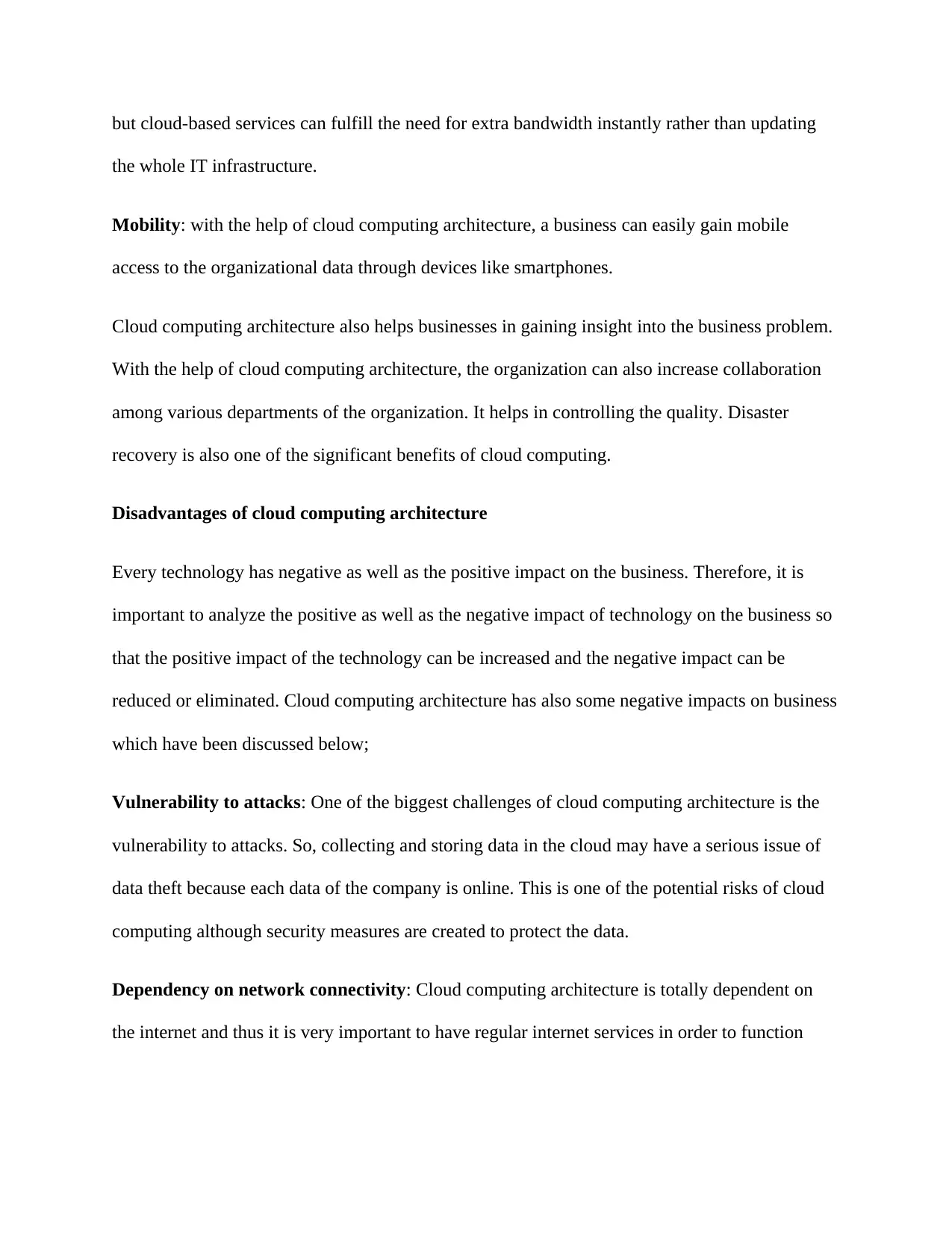
but cloud-based services can fulfill the need for extra bandwidth instantly rather than updating
the whole IT infrastructure.
Mobility: with the help of cloud computing architecture, a business can easily gain mobile
access to the organizational data through devices like smartphones.
Cloud computing architecture also helps businesses in gaining insight into the business problem.
With the help of cloud computing architecture, the organization can also increase collaboration
among various departments of the organization. It helps in controlling the quality. Disaster
recovery is also one of the significant benefits of cloud computing.
Disadvantages of cloud computing architecture
Every technology has negative as well as the positive impact on the business. Therefore, it is
important to analyze the positive as well as the negative impact of technology on the business so
that the positive impact of the technology can be increased and the negative impact can be
reduced or eliminated. Cloud computing architecture has also some negative impacts on business
which have been discussed below;
Vulnerability to attacks: One of the biggest challenges of cloud computing architecture is the
vulnerability to attacks. So, collecting and storing data in the cloud may have a serious issue of
data theft because each data of the company is online. This is one of the potential risks of cloud
computing although security measures are created to protect the data.
Dependency on network connectivity: Cloud computing architecture is totally dependent on
the internet and thus it is very important to have regular internet services in order to function
the whole IT infrastructure.
Mobility: with the help of cloud computing architecture, a business can easily gain mobile
access to the organizational data through devices like smartphones.
Cloud computing architecture also helps businesses in gaining insight into the business problem.
With the help of cloud computing architecture, the organization can also increase collaboration
among various departments of the organization. It helps in controlling the quality. Disaster
recovery is also one of the significant benefits of cloud computing.
Disadvantages of cloud computing architecture
Every technology has negative as well as the positive impact on the business. Therefore, it is
important to analyze the positive as well as the negative impact of technology on the business so
that the positive impact of the technology can be increased and the negative impact can be
reduced or eliminated. Cloud computing architecture has also some negative impacts on business
which have been discussed below;
Vulnerability to attacks: One of the biggest challenges of cloud computing architecture is the
vulnerability to attacks. So, collecting and storing data in the cloud may have a serious issue of
data theft because each data of the company is online. This is one of the potential risks of cloud
computing although security measures are created to protect the data.
Dependency on network connectivity: Cloud computing architecture is totally dependent on
the internet and thus it is very important to have regular internet services in order to function
⊘ This is a preview!⊘
Do you want full access?
Subscribe today to unlock all pages.

Trusted by 1+ million students worldwide
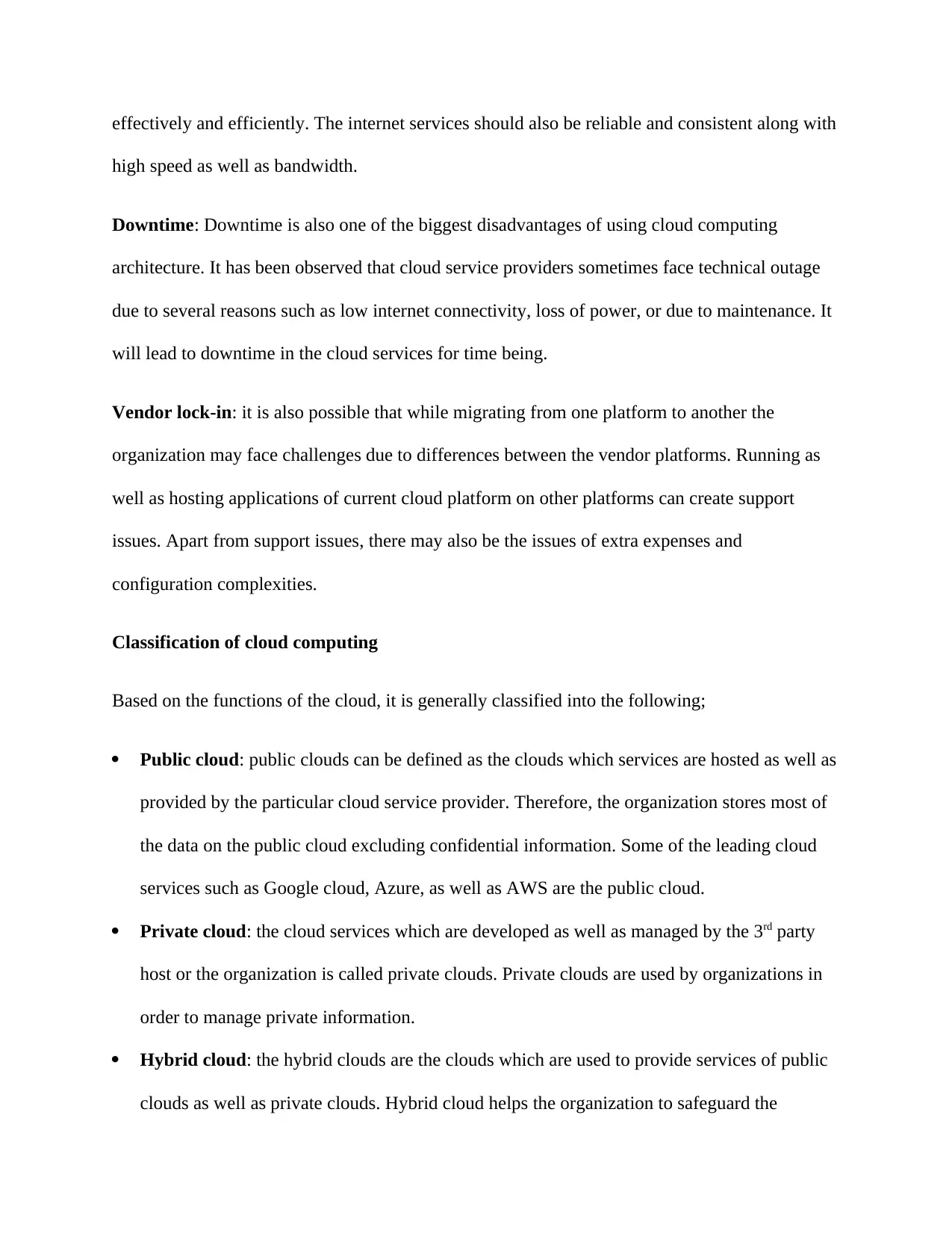
effectively and efficiently. The internet services should also be reliable and consistent along with
high speed as well as bandwidth.
Downtime: Downtime is also one of the biggest disadvantages of using cloud computing
architecture. It has been observed that cloud service providers sometimes face technical outage
due to several reasons such as low internet connectivity, loss of power, or due to maintenance. It
will lead to downtime in the cloud services for time being.
Vendor lock-in: it is also possible that while migrating from one platform to another the
organization may face challenges due to differences between the vendor platforms. Running as
well as hosting applications of current cloud platform on other platforms can create support
issues. Apart from support issues, there may also be the issues of extra expenses and
configuration complexities.
Classification of cloud computing
Based on the functions of the cloud, it is generally classified into the following;
Public cloud: public clouds can be defined as the clouds which services are hosted as well as
provided by the particular cloud service provider. Therefore, the organization stores most of
the data on the public cloud excluding confidential information. Some of the leading cloud
services such as Google cloud, Azure, as well as AWS are the public cloud.
Private cloud: the cloud services which are developed as well as managed by the 3rd party
host or the organization is called private clouds. Private clouds are used by organizations in
order to manage private information.
Hybrid cloud: the hybrid clouds are the clouds which are used to provide services of public
clouds as well as private clouds. Hybrid cloud helps the organization to safeguard the
high speed as well as bandwidth.
Downtime: Downtime is also one of the biggest disadvantages of using cloud computing
architecture. It has been observed that cloud service providers sometimes face technical outage
due to several reasons such as low internet connectivity, loss of power, or due to maintenance. It
will lead to downtime in the cloud services for time being.
Vendor lock-in: it is also possible that while migrating from one platform to another the
organization may face challenges due to differences between the vendor platforms. Running as
well as hosting applications of current cloud platform on other platforms can create support
issues. Apart from support issues, there may also be the issues of extra expenses and
configuration complexities.
Classification of cloud computing
Based on the functions of the cloud, it is generally classified into the following;
Public cloud: public clouds can be defined as the clouds which services are hosted as well as
provided by the particular cloud service provider. Therefore, the organization stores most of
the data on the public cloud excluding confidential information. Some of the leading cloud
services such as Google cloud, Azure, as well as AWS are the public cloud.
Private cloud: the cloud services which are developed as well as managed by the 3rd party
host or the organization is called private clouds. Private clouds are used by organizations in
order to manage private information.
Hybrid cloud: the hybrid clouds are the clouds which are used to provide services of public
clouds as well as private clouds. Hybrid cloud helps the organization to safeguard the
Paraphrase This Document
Need a fresh take? Get an instant paraphrase of this document with our AI Paraphraser
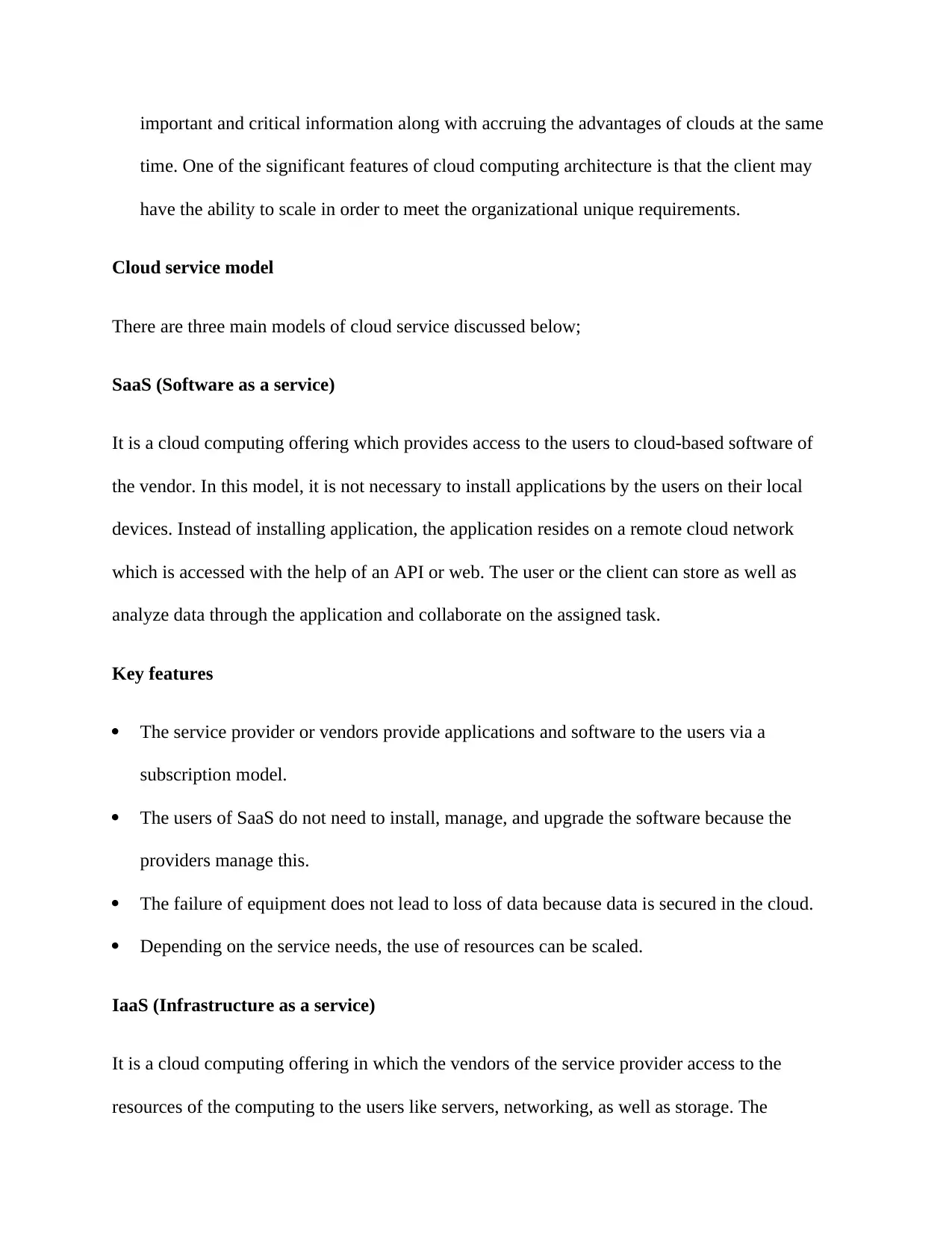
important and critical information along with accruing the advantages of clouds at the same
time. One of the significant features of cloud computing architecture is that the client may
have the ability to scale in order to meet the organizational unique requirements.
Cloud service model
There are three main models of cloud service discussed below;
SaaS (Software as a service)
It is a cloud computing offering which provides access to the users to cloud-based software of
the vendor. In this model, it is not necessary to install applications by the users on their local
devices. Instead of installing application, the application resides on a remote cloud network
which is accessed with the help of an API or web. The user or the client can store as well as
analyze data through the application and collaborate on the assigned task.
Key features
The service provider or vendors provide applications and software to the users via a
subscription model.
The users of SaaS do not need to install, manage, and upgrade the software because the
providers manage this.
The failure of equipment does not lead to loss of data because data is secured in the cloud.
Depending on the service needs, the use of resources can be scaled.
IaaS (Infrastructure as a service)
It is a cloud computing offering in which the vendors of the service provider access to the
resources of the computing to the users like servers, networking, as well as storage. The
time. One of the significant features of cloud computing architecture is that the client may
have the ability to scale in order to meet the organizational unique requirements.
Cloud service model
There are three main models of cloud service discussed below;
SaaS (Software as a service)
It is a cloud computing offering which provides access to the users to cloud-based software of
the vendor. In this model, it is not necessary to install applications by the users on their local
devices. Instead of installing application, the application resides on a remote cloud network
which is accessed with the help of an API or web. The user or the client can store as well as
analyze data through the application and collaborate on the assigned task.
Key features
The service provider or vendors provide applications and software to the users via a
subscription model.
The users of SaaS do not need to install, manage, and upgrade the software because the
providers manage this.
The failure of equipment does not lead to loss of data because data is secured in the cloud.
Depending on the service needs, the use of resources can be scaled.
IaaS (Infrastructure as a service)
It is a cloud computing offering in which the vendors of the service provider access to the
resources of the computing to the users like servers, networking, as well as storage. The
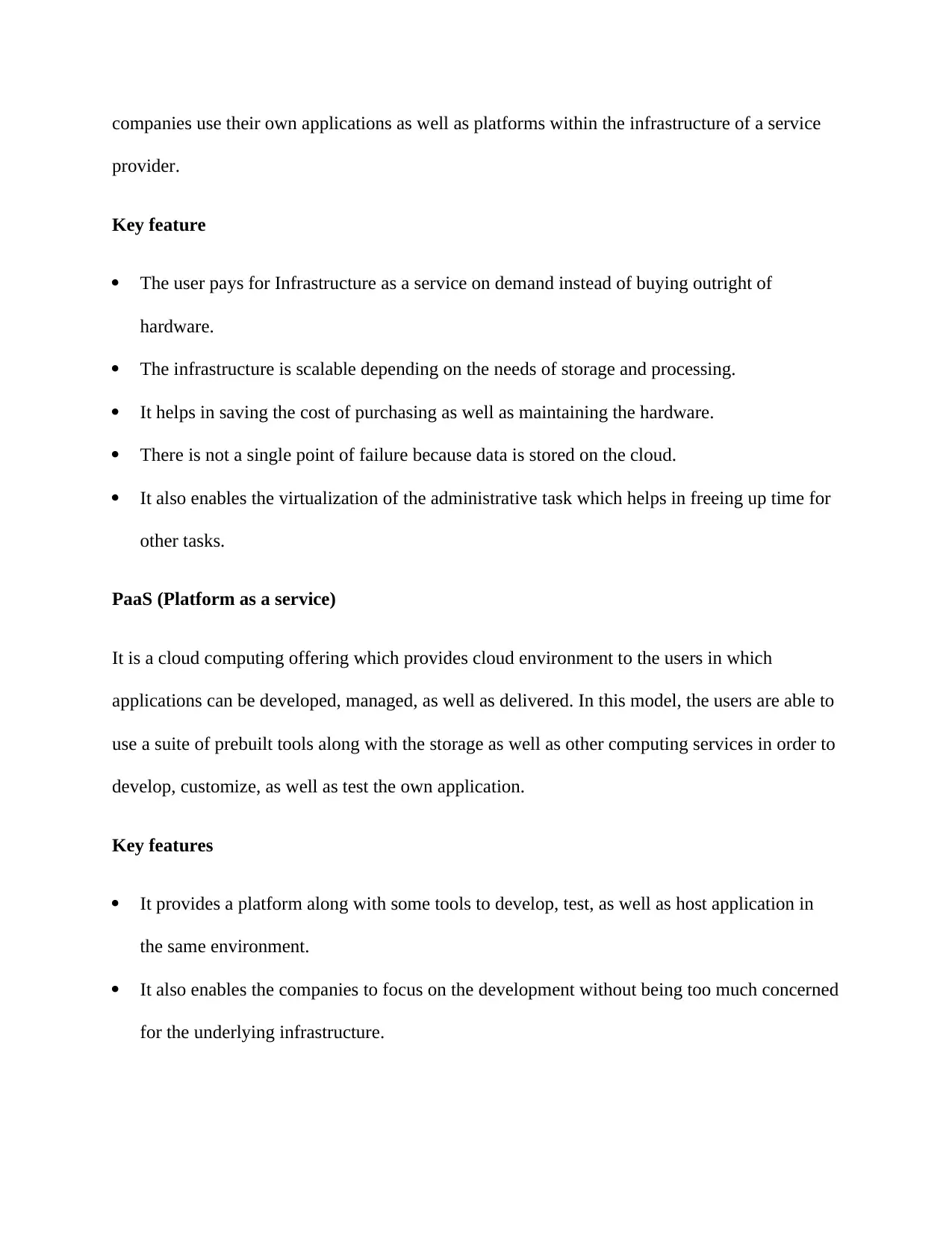
companies use their own applications as well as platforms within the infrastructure of a service
provider.
Key feature
The user pays for Infrastructure as a service on demand instead of buying outright of
hardware.
The infrastructure is scalable depending on the needs of storage and processing.
It helps in saving the cost of purchasing as well as maintaining the hardware.
There is not a single point of failure because data is stored on the cloud.
It also enables the virtualization of the administrative task which helps in freeing up time for
other tasks.
PaaS (Platform as a service)
It is a cloud computing offering which provides cloud environment to the users in which
applications can be developed, managed, as well as delivered. In this model, the users are able to
use a suite of prebuilt tools along with the storage as well as other computing services in order to
develop, customize, as well as test the own application.
Key features
It provides a platform along with some tools to develop, test, as well as host application in
the same environment.
It also enables the companies to focus on the development without being too much concerned
for the underlying infrastructure.
provider.
Key feature
The user pays for Infrastructure as a service on demand instead of buying outright of
hardware.
The infrastructure is scalable depending on the needs of storage and processing.
It helps in saving the cost of purchasing as well as maintaining the hardware.
There is not a single point of failure because data is stored on the cloud.
It also enables the virtualization of the administrative task which helps in freeing up time for
other tasks.
PaaS (Platform as a service)
It is a cloud computing offering which provides cloud environment to the users in which
applications can be developed, managed, as well as delivered. In this model, the users are able to
use a suite of prebuilt tools along with the storage as well as other computing services in order to
develop, customize, as well as test the own application.
Key features
It provides a platform along with some tools to develop, test, as well as host application in
the same environment.
It also enables the companies to focus on the development without being too much concerned
for the underlying infrastructure.
⊘ This is a preview!⊘
Do you want full access?
Subscribe today to unlock all pages.

Trusted by 1+ million students worldwide

The service providers manage the security issues, server software, operating system, as well
as backups.
Functions of cloud architecture
Cloud architecture has become of the most significant parts of the businesses because it helps the
businesses to solve their problems or issues. It plays a significant role in securing important data
of the business and hence the business can function effectively and efficiently in the market. The
following are the functions of cloud computing architecture;
Storing important data of the business
The businesses use cloud computing architecture to store important data of the business. It does
not only store the data but allows the organization to have access to the stored data at any point
of time so that the organization can benefit out of it. It is very important to store important data
because it can help in analyzing the data to identify the trends in the market.
Ensuring the security of the data
It is also very important to ensure the security of the data in order to work effectively and
efficiently in the market. There is a threat to the market of being attacked by hackers. There are
several hackers in the market who can damage the data and the organization can suffer a huge
loss of data as well as critical information. So, cloud computing architecture ensures the security
of the data.
Helps in solving the business problem
Cloud computing architecture helps in solving a business problem. Every organization faces
several business-related issues every day. The organization should deal with the issues
as backups.
Functions of cloud architecture
Cloud architecture has become of the most significant parts of the businesses because it helps the
businesses to solve their problems or issues. It plays a significant role in securing important data
of the business and hence the business can function effectively and efficiently in the market. The
following are the functions of cloud computing architecture;
Storing important data of the business
The businesses use cloud computing architecture to store important data of the business. It does
not only store the data but allows the organization to have access to the stored data at any point
of time so that the organization can benefit out of it. It is very important to store important data
because it can help in analyzing the data to identify the trends in the market.
Ensuring the security of the data
It is also very important to ensure the security of the data in order to work effectively and
efficiently in the market. There is a threat to the market of being attacked by hackers. There are
several hackers in the market who can damage the data and the organization can suffer a huge
loss of data as well as critical information. So, cloud computing architecture ensures the security
of the data.
Helps in solving the business problem
Cloud computing architecture helps in solving a business problem. Every organization faces
several business-related issues every day. The organization should deal with the issues
Paraphrase This Document
Need a fresh take? Get an instant paraphrase of this document with our AI Paraphraser
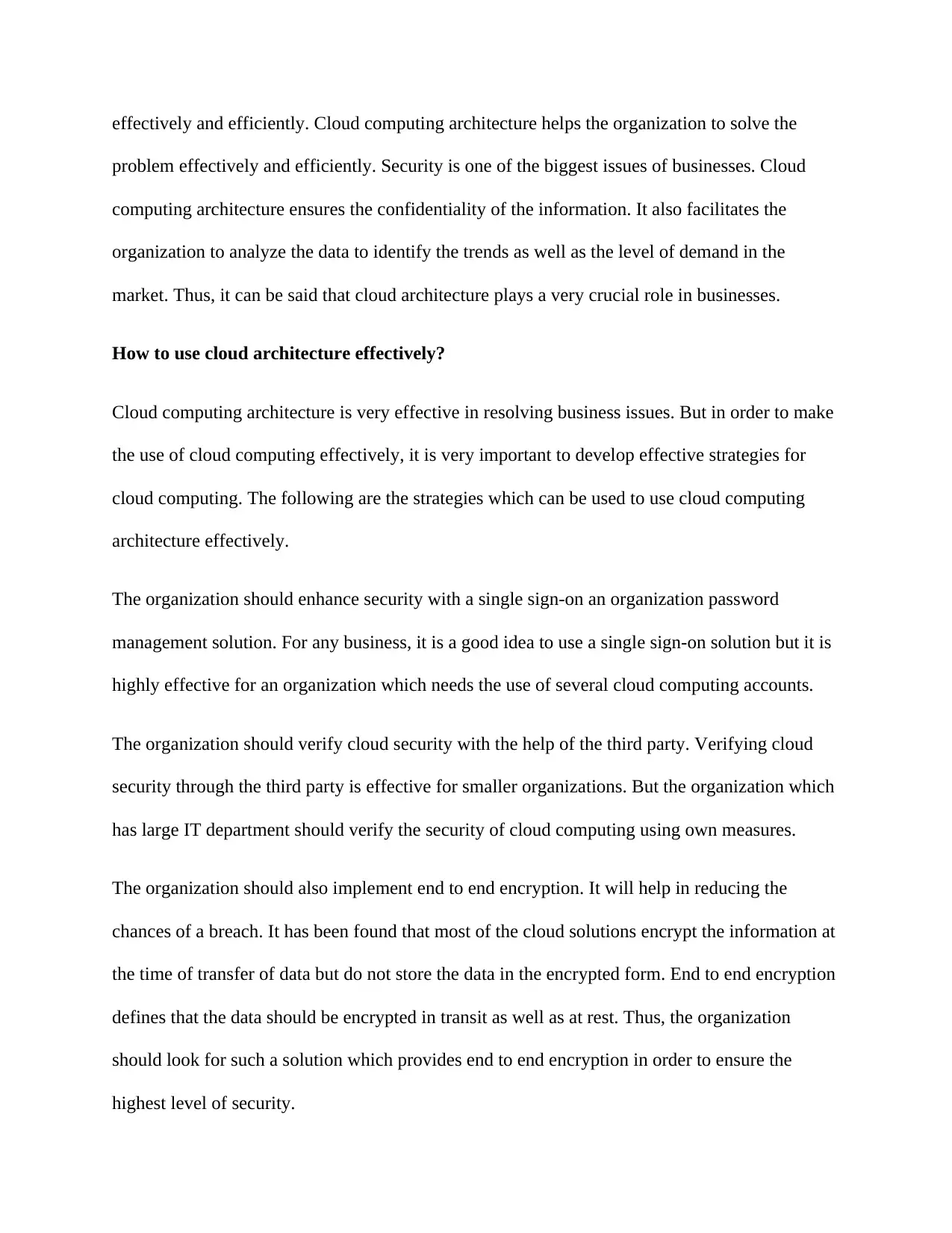
effectively and efficiently. Cloud computing architecture helps the organization to solve the
problem effectively and efficiently. Security is one of the biggest issues of businesses. Cloud
computing architecture ensures the confidentiality of the information. It also facilitates the
organization to analyze the data to identify the trends as well as the level of demand in the
market. Thus, it can be said that cloud architecture plays a very crucial role in businesses.
How to use cloud architecture effectively?
Cloud computing architecture is very effective in resolving business issues. But in order to make
the use of cloud computing effectively, it is very important to develop effective strategies for
cloud computing. The following are the strategies which can be used to use cloud computing
architecture effectively.
The organization should enhance security with a single sign-on an organization password
management solution. For any business, it is a good idea to use a single sign-on solution but it is
highly effective for an organization which needs the use of several cloud computing accounts.
The organization should verify cloud security with the help of the third party. Verifying cloud
security through the third party is effective for smaller organizations. But the organization which
has large IT department should verify the security of cloud computing using own measures.
The organization should also implement end to end encryption. It will help in reducing the
chances of a breach. It has been found that most of the cloud solutions encrypt the information at
the time of transfer of data but do not store the data in the encrypted form. End to end encryption
defines that the data should be encrypted in transit as well as at rest. Thus, the organization
should look for such a solution which provides end to end encryption in order to ensure the
highest level of security.
problem effectively and efficiently. Security is one of the biggest issues of businesses. Cloud
computing architecture ensures the confidentiality of the information. It also facilitates the
organization to analyze the data to identify the trends as well as the level of demand in the
market. Thus, it can be said that cloud architecture plays a very crucial role in businesses.
How to use cloud architecture effectively?
Cloud computing architecture is very effective in resolving business issues. But in order to make
the use of cloud computing effectively, it is very important to develop effective strategies for
cloud computing. The following are the strategies which can be used to use cloud computing
architecture effectively.
The organization should enhance security with a single sign-on an organization password
management solution. For any business, it is a good idea to use a single sign-on solution but it is
highly effective for an organization which needs the use of several cloud computing accounts.
The organization should verify cloud security with the help of the third party. Verifying cloud
security through the third party is effective for smaller organizations. But the organization which
has large IT department should verify the security of cloud computing using own measures.
The organization should also implement end to end encryption. It will help in reducing the
chances of a breach. It has been found that most of the cloud solutions encrypt the information at
the time of transfer of data but do not store the data in the encrypted form. End to end encryption
defines that the data should be encrypted in transit as well as at rest. Thus, the organization
should look for such a solution which provides end to end encryption in order to ensure the
highest level of security.
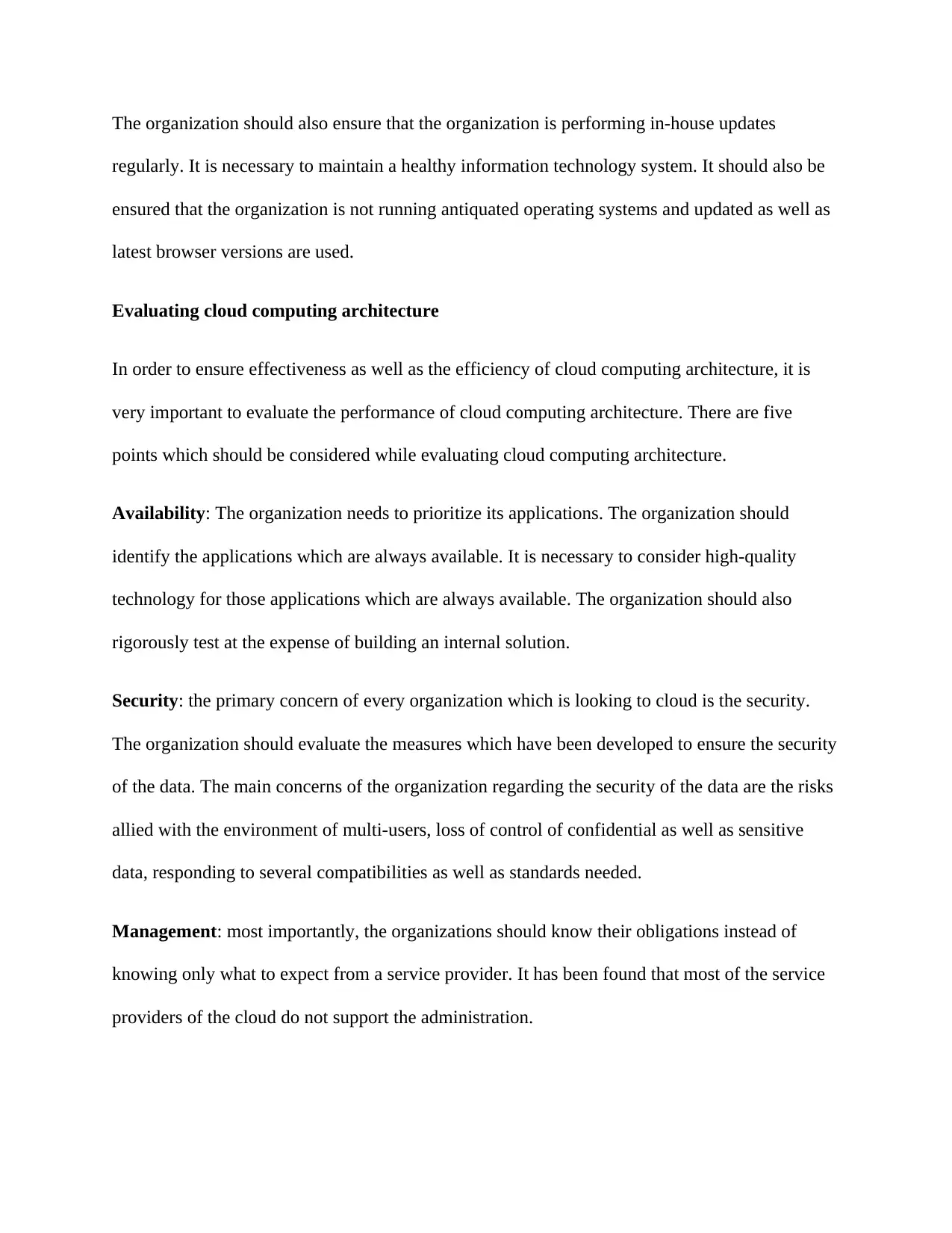
The organization should also ensure that the organization is performing in-house updates
regularly. It is necessary to maintain a healthy information technology system. It should also be
ensured that the organization is not running antiquated operating systems and updated as well as
latest browser versions are used.
Evaluating cloud computing architecture
In order to ensure effectiveness as well as the efficiency of cloud computing architecture, it is
very important to evaluate the performance of cloud computing architecture. There are five
points which should be considered while evaluating cloud computing architecture.
Availability: The organization needs to prioritize its applications. The organization should
identify the applications which are always available. It is necessary to consider high-quality
technology for those applications which are always available. The organization should also
rigorously test at the expense of building an internal solution.
Security: the primary concern of every organization which is looking to cloud is the security.
The organization should evaluate the measures which have been developed to ensure the security
of the data. The main concerns of the organization regarding the security of the data are the risks
allied with the environment of multi-users, loss of control of confidential as well as sensitive
data, responding to several compatibilities as well as standards needed.
Management: most importantly, the organizations should know their obligations instead of
knowing only what to expect from a service provider. It has been found that most of the service
providers of the cloud do not support the administration.
regularly. It is necessary to maintain a healthy information technology system. It should also be
ensured that the organization is not running antiquated operating systems and updated as well as
latest browser versions are used.
Evaluating cloud computing architecture
In order to ensure effectiveness as well as the efficiency of cloud computing architecture, it is
very important to evaluate the performance of cloud computing architecture. There are five
points which should be considered while evaluating cloud computing architecture.
Availability: The organization needs to prioritize its applications. The organization should
identify the applications which are always available. It is necessary to consider high-quality
technology for those applications which are always available. The organization should also
rigorously test at the expense of building an internal solution.
Security: the primary concern of every organization which is looking to cloud is the security.
The organization should evaluate the measures which have been developed to ensure the security
of the data. The main concerns of the organization regarding the security of the data are the risks
allied with the environment of multi-users, loss of control of confidential as well as sensitive
data, responding to several compatibilities as well as standards needed.
Management: most importantly, the organizations should know their obligations instead of
knowing only what to expect from a service provider. It has been found that most of the service
providers of the cloud do not support the administration.
⊘ This is a preview!⊘
Do you want full access?
Subscribe today to unlock all pages.

Trusted by 1+ million students worldwide
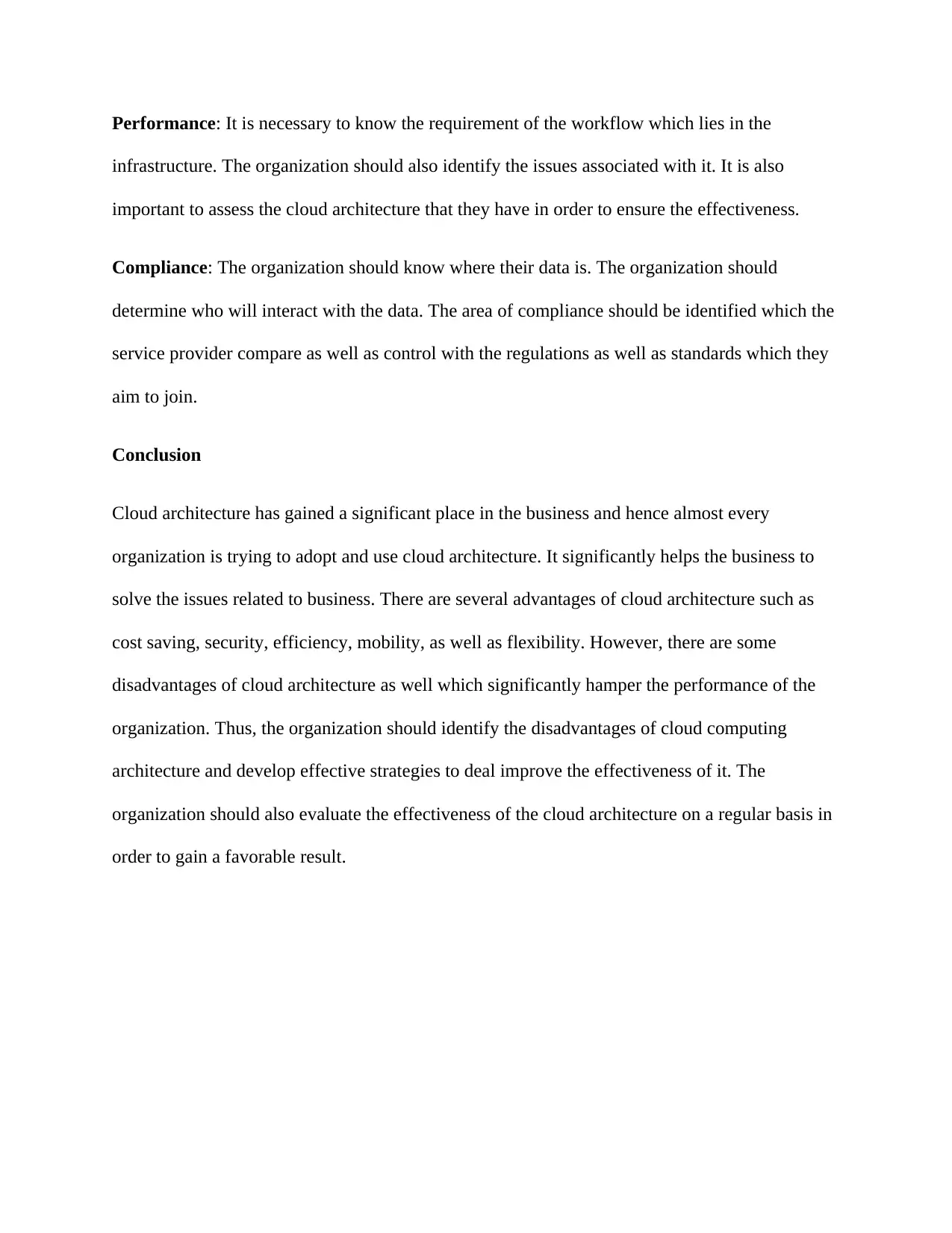
Performance: It is necessary to know the requirement of the workflow which lies in the
infrastructure. The organization should also identify the issues associated with it. It is also
important to assess the cloud architecture that they have in order to ensure the effectiveness.
Compliance: The organization should know where their data is. The organization should
determine who will interact with the data. The area of compliance should be identified which the
service provider compare as well as control with the regulations as well as standards which they
aim to join.
Conclusion
Cloud architecture has gained a significant place in the business and hence almost every
organization is trying to adopt and use cloud architecture. It significantly helps the business to
solve the issues related to business. There are several advantages of cloud architecture such as
cost saving, security, efficiency, mobility, as well as flexibility. However, there are some
disadvantages of cloud architecture as well which significantly hamper the performance of the
organization. Thus, the organization should identify the disadvantages of cloud computing
architecture and develop effective strategies to deal improve the effectiveness of it. The
organization should also evaluate the effectiveness of the cloud architecture on a regular basis in
order to gain a favorable result.
infrastructure. The organization should also identify the issues associated with it. It is also
important to assess the cloud architecture that they have in order to ensure the effectiveness.
Compliance: The organization should know where their data is. The organization should
determine who will interact with the data. The area of compliance should be identified which the
service provider compare as well as control with the regulations as well as standards which they
aim to join.
Conclusion
Cloud architecture has gained a significant place in the business and hence almost every
organization is trying to adopt and use cloud architecture. It significantly helps the business to
solve the issues related to business. There are several advantages of cloud architecture such as
cost saving, security, efficiency, mobility, as well as flexibility. However, there are some
disadvantages of cloud architecture as well which significantly hamper the performance of the
organization. Thus, the organization should identify the disadvantages of cloud computing
architecture and develop effective strategies to deal improve the effectiveness of it. The
organization should also evaluate the effectiveness of the cloud architecture on a regular basis in
order to gain a favorable result.
1 out of 10
Related Documents
Your All-in-One AI-Powered Toolkit for Academic Success.
+13062052269
info@desklib.com
Available 24*7 on WhatsApp / Email
![[object Object]](/_next/static/media/star-bottom.7253800d.svg)
Unlock your academic potential
Copyright © 2020–2025 A2Z Services. All Rights Reserved. Developed and managed by ZUCOL.




